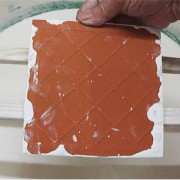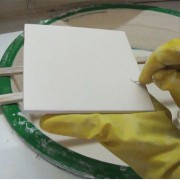GLAZE-BASE (d) Thickness
 Glaze-base thickness.
Glaze-base thickness.
By controlling the viscosity and specific gravity of the glaze-base, the desired glaze thickness can be achieved. The porosity of the bisque will determine the absorption rate, and is dependent on the type of clays it has been made with and temperature to which it has been fired. As you work with different types of bisque and firing schedules, you will obtain a feel for the porosity and how thick the glaze should be.
I have found that handmade, brown clay bisque needs a thick coat of glaze-base; white bisque needs more water and industrially made, brown clay tiles even more. If the glaze is too thin, when fired, the color of the bisque can be seen through it but you might want this, as it can help to give an antique look. If the glaze-base is too thick, it can cause problems such as lifting, crawling, etc., during the firing. You must experiment to determine your taste and the right consistency to match the type of bisque you are using. To test the thickness of the glaze-base, prepare one tile with it and wait a few seconds until it has dried enough to move it. It can then be checked in the following ways:
Working Process
1) If the glaze-base on the back of the tile, is around the edges and lumpy, it is too thick. Simply add more water and stir.
2) If the glaze-base is too thin, leave it to settle; the glaze will fall to the bottom and the water will form a layer on top. Scoop out the unnecessary water, using a slightly curved plate. Stir well and start again.
3) When you are stirring the glaze-base by hand, pull out your hand, close your fist and the glaze on the back of it gives you a good, quick idea of its thickness.
4) Scratch the glaze-base on the tile with a fine instrument to see its thickness. I use a straightened paper clip for this.
Testing equipment such as hydrometers, viscosity cups, and viscometers can help in testing the density of your glaze.
Keep the water you remove; even though it looks clean there is still a lot of glaze in it. Let it stand and the glaze and water will separate. If the glaze is clean, stir it and put it back with the prepared glaze. If not, pour off all the excess water and scrape the damp glaze into the box in which you keep this type of dirty glaze.
Read more about: Boxes for dirty glazes




